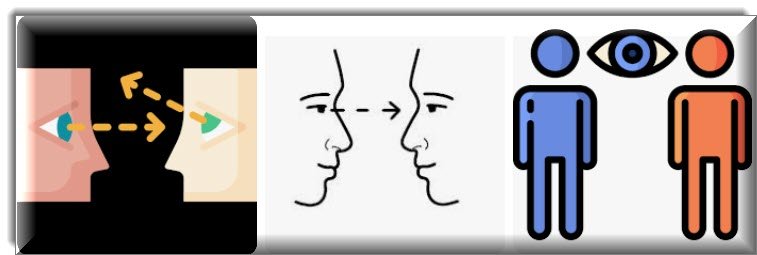“The Unspoken Language of Eye Contact: Understanding Why People Look Away During Conversations”

The Unspoken Language of Eye Contact: Understanding Why People Look Away During ConversationsAs we engage in conversations, we rely on various non-verbal cues to infer meaning, establish connections, and communicate our thoughts and emotions effectively. One such non-verbal signal is eye contact, which holds immense significance in human communication. However, it is not uncommon to notice individuals looking away during conversations. Why do people engage in this behavior? In this article, we delve into the underlying reasons behind the tendency to look away when talking to someone, exploring the complex intricacies of non-verbal communication.

- Cultural and Social Norms: Cultural and social norms play a significant role in shaping our behavior during conversations. Some societies prioritize maintaining eye contact as a sign of respect and attentiveness, while others perceive a direct gaze as intrusive or disrespectful. Therefore, when people look away during a conversation, it might be a reflection of their upbringing, cultural background, or adherence to specific societal norms.
- Emotional Discomfort: Human emotions possess tremendous power over our behavior and communication patterns. When we experience intense emotions such as guilt, shame, embarrassment, or anxiety, we may instinctively avert our gaze to reduce discomfort or shield ourselves from potential judgment. Looking away can be an unconscious attempt to regulate our emotions or protect our vulnerability during sensitive conversations.
- Intimidation and Dominance: Eye contact can also convey dominance, power dynamics, or intimidation. In certain situations, individuals may intentionally break eye contact to exert control or assert dominance over others. Conversely, if a person is intimidated by someone’s presence or authority, they might look away as a way to protect themselves or avoid confrontation.
- Concentration and Cognitive Overload: Engaging in a conversation requires active cognitive processing and concentration. Sometimes, people may look away momentarily to gather their thoughts, process information, or search for the right words to respond effectively. This break in eye contact does not necessarily indicate disinterest but rather reflects the cognitive effort involved in processing complex information.
- Cultural Differences in Eye Contact: Cross-cultural differences in communication styles also contribute to the variation in eye contact patterns. In some cultures, it is customary to maintain prolonged eye contact during conversations, emphasizing attentiveness and engagement. However, in other cultures, individuals may perceive direct eye contact as intimidating or impolite, causing them to look away to demonstrate respect and deference.
- Distractions and External Stimuli: Our surroundings can significantly impact our focus and gaze. If there are distractions, such as noise or movement in the environment, individuals may inadvertently look away to regain focus or direct attention toward the source of the distraction. Similarly, if a person’s attention is momentarily captured by something visually captivating, they may break eye contact without any intention to disengage from the conversation.
- Personal Anxieties and Insecurities: Individuals with social anxiety or self-esteem issues often find direct eye contact anxiety-inducing. They may perceive sustained eye contact as threatening or uncomfortable, leading them to avert their gaze as a coping mechanism. These individuals might fear judgment, rejection, or feel overwhelmed by the intensity of interpersonal connections.

The art of conversation encompasses both verbal and non-verbal elements, with eye contact being a prominent non-verbal cue. While maintaining eye contact is generally considered effective communication, the tendency to look away during conversations holds multiple underlying reasons. Cultural norms, emotional discomfort, power dynamics, cognitive processes, distractions, and personal anxieties all contribute to this behavior. Recognizing these factors can help foster better understanding and empathy in our interactions, allowing us to navigate the complexity of human communication more compassionately.
Throughout his career, Roy Swire has remained true to his roots, using his artistry to inspire and uplift others. Whether through his music, writing, or activism, he continues to make a meaningful impact on the world, proving that art has the power to transcend boundaries and unite people from all walks of life.
Related News

My Private Proxy: Your Ultimate Proxy Solution
Spread the love My Private Proxy: Your Ultimate Proxy Solution Are you tired of unreliableRead More

“From Rags to Riches: The Roadmap to Wealth According to John Paul DeJoria”
Spread the loveJohn Paul DeJoria is a name that may not be familiar to everyone,Read More
